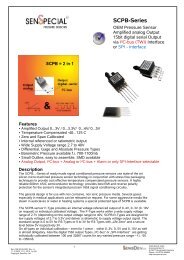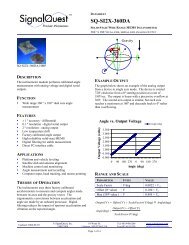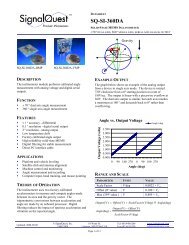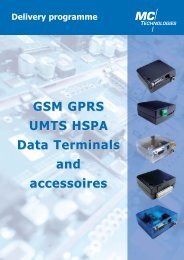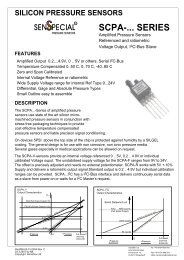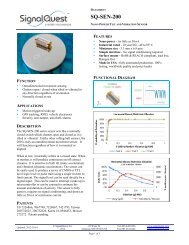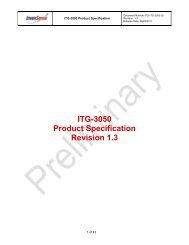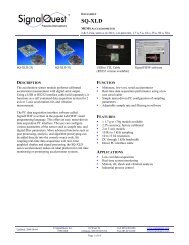MPU-6000 and MPU-6050 Product Specification Revision 1.0
MPU-6000 and MPU-6050 Product Specification Revision 1.0
MPU-6000 and MPU-6050 Product Specification Revision 1.0
You also want an ePaper? Increase the reach of your titles
YUMPU automatically turns print PDFs into web optimized ePapers that Google loves.
<strong>MPU</strong>-<strong>6000</strong>/<strong>MPU</strong>-<strong>6050</strong> <strong>Product</strong> <strong>Specification</strong>Document Number: PS-<strong>MPU</strong>-<strong>6000</strong>A-00<strong>Revision</strong>: <strong>1.0</strong>Release Date: 11/24/201012.4.4 COMPONENT PLACEMENT .............................................................................................................. 4412.4.5 PCB MOUNTING AND CROSS-AXIS SENSITIVITY .............................................................................. 4412.4.6 MEMS HANDLING INSTRUCTIONS .................................................................................................. 4512.4.7 ESD CONSIDERATIONS ................................................................................................................. 4512.4.8 REFLOW SPECIFICATION ................................................................................................................ 4512.4.9 STORAGE SPECIFICATIONS ............................................................................................................ 4712.4.10 GYRO REMOVAL FROM PCB .......................................................................................................... 4712.5 PACKAGE MARKING SPECIFICATION .................................................................................................... 4712.6 TAPE & REEL SPECIFICATION ............................................................................................................. 4812.7 LABEL ............................................................................................................................................... 5012.8 PACKAGING ....................................................................................................................................... 5013 RELIABILITY ............................................................................................................................................. 5113.1 QUALIFICATION TEST POLICY ............................................................................................................. 5113.2 QUALIFICATION TEST PLAN ................................................................................................................ 5114 ENVIRONMENTAL COMPLIANCE ........................................................................................................... 52CONFIDENTIAL & PROPRIETARY 4 of 53
<strong>MPU</strong>-<strong>6000</strong>/<strong>MPU</strong>-<strong>6050</strong> <strong>Product</strong> <strong>Specification</strong>Document Number: PS-<strong>MPU</strong>-<strong>6000</strong>A-00<strong>Revision</strong>: <strong>1.0</strong>Release Date: 11/24/2010The <strong>MPU</strong>-<strong>6000</strong> <strong>and</strong> <strong>MPU</strong>-<strong>6050</strong> are identical, except that the <strong>MPU</strong>-<strong>6050</strong> supports the I 2 C serial interface only,<strong>and</strong> has a separate VLOGIC reference pin. The <strong>MPU</strong>-<strong>6000</strong> supports both I 2 C <strong>and</strong> SPI interfaces <strong>and</strong> has asingle supply pin, VDD, which is both the device’s logic reference supply <strong>and</strong> the analog supply for the part.The table below outlines these differences:Primary Differences between <strong>MPU</strong>-<strong>6000</strong> <strong>and</strong> <strong>MPU</strong>-<strong>6050</strong>Part / Item <strong>MPU</strong>-<strong>6000</strong> <strong>MPU</strong>-<strong>6050</strong>VDD2.5V±5%, 3.0V±5%, or3.3V±5%.2.5V±5%, 3.0V±5%, or3.3V±5%.VLOGIC n/a 1.71V to VDDSerial Interfaces Supported I 2 C, SPI I 2 CPin 8 /CS VLOGICPin 9 AD0/SDO AD0Pin 23 SCL/SCLK SCLPin 24 SDA/SDI SDA4 Applications• BlurFree technology (for Video/Still Image Stabilization)• AirSign technology (for Security/Authentication)• TouchAnywhere technology (for “no touch” UI Application Control/Navigation)• MotionComm<strong>and</strong> technology (for Gesture Short-cuts)• Motion-enabled game <strong>and</strong> application framework• InstantGesture iG gesture recognition• Location based services, points of interest, <strong>and</strong> dead reckoning• H<strong>and</strong>set <strong>and</strong> portable gaming• Motion-based game controllers• 3D remote controls for Internet connected DTVs <strong>and</strong> set top boxes, 3D mice• Wearable sensors for health, fitness <strong>and</strong> sports• ToysCONFIDENTIAL & PROPRIETARY 7 of 53
<strong>MPU</strong>-<strong>6000</strong>/<strong>MPU</strong>-<strong>6050</strong> <strong>Product</strong> <strong>Specification</strong>Document Number: PS-<strong>MPU</strong>-<strong>6000</strong>A-00<strong>Revision</strong>: <strong>1.0</strong>Release Date: 11/24/20105 Features5.1 Gyroscope FeaturesThe triple-axis MEMS gyroscope in the <strong>MPU</strong>-60X0 includes a wide range of features:• Digital-output X-, Y-, <strong>and</strong> Z-Axis angular rate sensors (gyroscopes) with a user-programmable fullscalerange of ±250, ±500, ±1000, <strong>and</strong> ±2000°/sec• External sync signal connected to the FSYNC pin supports image, video <strong>and</strong> GPS synchronization• Integrated 16-bit ADCs provide simultaneous sampling of gyros• Enhanced bias <strong>and</strong> sensitivity temperature stability reduces the need for user calibration• Improved low-frequency noise performance• Digitally-programmable low-pass filter• Gyroscope operating current: 5mA• St<strong>and</strong>by current: 5µA• Factory calibrated sensitivity scale factor• User self-test5.2 Accelerometer FeaturesThe triple-axis MEMS accelerometer in <strong>MPU</strong>-60X0 includes a wide range of features:• Digital-output tri-axis accelerometer with a programmable full scale range of ±2g, ±4g, ±8g <strong>and</strong> ±16g• Integrated 16-bit ADCs provide simultaneous sampling of accelerometers while requiring no externalmultiplexer• Accel normal operating current: 500µA• Low power accelerometer mode current: 40µA at 10 Hz• Orientation detection <strong>and</strong> signaling• Tap detection• User-programmable interrupts• Free-fall interrupt• High-G interrupt• Zero-motion/Motion interrupt• User self test5.3 Additional FeaturesThe <strong>MPU</strong>-60X0 includes the following additional features:• 9-Axis sensor fusion via on-chip Digital Motion Processor (DMP)• Auxiliary master I 2 C bus for reading data from external sensors (e.g., magnetometer)• 5.5mA operating current for all 6 axes• VDD supply voltages of 2.5V±5%, 3.0V±5%, 3.3V±5%• Flexible VLOGIC reference voltage allows for multiple I 2 C interface voltages (<strong>MPU</strong>-<strong>6050</strong> only)• Smallest <strong>and</strong> thinnest package for portable devices: 4x4x0.9mm QFN• Minimal cross-axis sensitivity between the accelerometer <strong>and</strong> gyroscope axes• 1024 byte FIFO reduces power consumption by allowing host processor to read the data in bursts<strong>and</strong> then go into a low-power mode as the FIFO collects more data• Digital-output temperature sensor• User-programmable digital filters for gyroscope, accelerometer, <strong>and</strong> temp sensor• 10,000 g shock tolerant• 400kHz Fast Mode I 2 C for communicating with all registersCONFIDENTIAL & PROPRIETARY 8 of 53
<strong>MPU</strong>-<strong>6000</strong>/<strong>MPU</strong>-<strong>6050</strong> <strong>Product</strong> <strong>Specification</strong>Document Number: PS-<strong>MPU</strong>-<strong>6000</strong>A-00<strong>Revision</strong>: <strong>1.0</strong>Release Date: 11/24/20106 Electrical Characteristics6.1 Gyroscope <strong>Specification</strong>sVDD = 2.5V±5%, 3.0V±5%, or 3.3V±5%, VLOGIC (<strong>MPU</strong>-<strong>6050</strong> only) = 1.8V±5% or VDD, T A = 25°CPARAMETER CONDITIONS MIN TYP MAX UNITS NOTESGYROSCOPE SENSITIVITYFull-Scale Range FS_SEL=3 ±2000 º/sFS_SEL=2 ±1000 º/sFS_SEL=1 ±500 º/sFS_SEL=0 ±250 º/sGyroscope ADC Word Length 16 BitsSensitivity Scale Factor FS_SEL=0 131 LSB/(º/s)FS_SEL=1 65.5 LSB/(º/s)FS_SEL=2 32.8 LSB/(º/s)FS_SEL=3 16.4 LSB/(º/s)Sensitivity Scale Factor Tolerance 25°C -3 +3 %Sensitivity Scale Factor Variation Over±2 %TemperatureNonlinearity Best fit straight line; 25°C 0.2 %Cross-Axis Sensitivity ±2 %GYROSCOPE ZERO-RATE OUTPUT (ZRO)Initial ZRO Tolerance 25°C ±20 º/sZRO Variation Over Temperature -40°C to +85°C ±20 º/sPower-Supply Sensitivity (1-10Hz) Sine wave, 100mVpp; VDD=2.5V 0.2 º/sPower-Supply Sensitivity (10 - 250Hz) Sine wave, 100mVpp; VDD=2.5V 0.2 º/sPower-Supply Sensitivity (250Hz - 100kHz) Sine wave, 100mVpp; VDD=2.5V 4 º/sLinear Acceleration Sensitivity Static 0.1 º/s/gGYROSCOPE NOISE PERFORMANCE FS_SEL=0Total RMS Noise DLPFCFG=2 (100Hz) 0.05 º/s-rmsLow-frequency RMS noise B<strong>and</strong>width 1Hz to10Hz 0.033 º/s-rmsRate Noise Spectral Density At 10Hz 0.005 º/s/√HzGYROSCOPE MECHANICALFREQUENCIESX-Axis 30 33 36 kHzY-Axis 27 30 33 kHzZ-Axis 24 27 30 kHzSELF TEST RESPONSEX, Y, <strong>and</strong> Z axes 50 º/sOUTPUT DATA RATEProgrammable 4 8,000 HzGYROSCOPE START-UP TIMEDLPFCFG=0ZRO Settling to ±1º/s of Final 30 msCONFIDENTIAL & PROPRIETARY 10 of 53
<strong>MPU</strong>-<strong>6000</strong>/<strong>MPU</strong>-<strong>6050</strong> <strong>Product</strong> <strong>Specification</strong>Document Number: PS-<strong>MPU</strong>-<strong>6000</strong>A-00<strong>Revision</strong>: <strong>1.0</strong>Release Date: 11/24/20106.2 Accelerometer <strong>Specification</strong>sVDD = 2.5V±5%, 3.0V±5%, or 3.3V±5%, VLOGIC (<strong>MPU</strong>-<strong>6050</strong> only) = 1.8V±5% or VDD, T A = 25°CPARAMETER CONDITIONS MIN TYP MAX UNITS NOTESACCELEROMETER SENSITIVITYFull-Scale Range ±2g mode ±2 g±4g mode ±4 g±8g mode ±8 g±16g mode ±16 gADC Word Length Output in two’s complement format 16 BitsSensitivity Scale Factor ±2g mode 0.06 mg/LSB±4g mode 0.12 mg/LSB±8g mode 0.24 mg/LSB±16g mode 0.49 mg/LSBInitial Calibration Tolerance ±3 %Sensitivity Change vs. Temperature (±2g) ±0.02 %/°CNonlinearity Best Fit Straight Line 0.5 %Cross-Axis Sensitivity ±2 %ZERO-G OUTPUTInitial Calibration Tolerance ±50 mgZero-G Level Change vs. Temperature ±1 mg/°CSELF TEST RESPONSEX, Y, <strong>and</strong> Z axes 0.5 gNOISE PERFORMANCEPower Spectral Density @10Hz 350 µg/√HzLOW PASS FILTER RESPONSEProgrammable Range 5 250 HzOUTPUT DATA RATEProgrammable Range 4 1,000 HzCONFIDENTIAL & PROPRIETARY 11 of 53
<strong>MPU</strong>-<strong>6000</strong>/<strong>MPU</strong>-<strong>6050</strong> <strong>Product</strong> <strong>Specification</strong>Document Number: PS-<strong>MPU</strong>-<strong>6000</strong>A-00<strong>Revision</strong>: <strong>1.0</strong>Release Date: 11/24/20106.3 Electrical <strong>and</strong> Other Common <strong>Specification</strong>sVDD = 2.5V±5%, 3.0V±5%, or 3.3V±5%, VLOGIC (<strong>MPU</strong>-<strong>6050</strong> only) = 1.8V±5% or VDD, T A = 25°CPARAMETER CONDITIONS MIN TYP MAX Units NotesVDD POWER SUPPLYOperating Voltages 2.5±5% V3.0±5% V3.3±5% VNormal Operating Current Gyroscope + Accelerometer + DMP 5.5 mAGyroscope + DMP5.0 mA(Accelerometer disabled)Accelerometer only500 µA(DMP & Gyroscope disabled)Accelerometer Low Power Mode 10Hz update rate 40 µACurrentFull-Chip Idle Mode Supply Current 5 µAPower Supply Ramp Rate Monotonic ramp. Ramp rate is 10%100 msto 90% of the final valueVLOGIC REFERENCE VOLTAGE <strong>MPU</strong>-<strong>6050</strong> onlyVoltage Range VLOGIC must be ≤VDD at all times 1.71 VDD VPower Supply Ramp Rate Monotonic ramp. Ramp rate is 10%3 msto 90% of the final valueNormal Operating Current 100 µASTART-UP TIME FOR REGISTERREAD/WRITE20 100 msTEMPERATURE RANGESpecified Temperature RangeSERIAL INTERFACESPI Operating Frequency, AllRegisters Read/WriteSPI Operating Frequency, Sensor<strong>and</strong> Interrupt Registers Read OnlyPerformance parameters are notapplicable beyond SpecifiedTemperature Range-40 +85 °C<strong>MPU</strong>-<strong>6000</strong> only, Low Speed100 ±10% kHzCharacterization<strong>MPU</strong>-<strong>6000</strong> only, High SpeedCharacterization1 ±10% MHz<strong>MPU</strong>-<strong>6000</strong> only 20 ±10% MHzI 2 C Operating Frequency All registers, Fast-mode 400 kHzAll registers, St<strong>and</strong>ard-mode 100 kHzCONFIDENTIAL & PROPRIETARY 12 of 53
<strong>MPU</strong>-<strong>6000</strong>/<strong>MPU</strong>-<strong>6050</strong> <strong>Product</strong> <strong>Specification</strong>Document Number: PS-<strong>MPU</strong>-<strong>6000</strong>A-00<strong>Revision</strong>: <strong>1.0</strong>Release Date: 11/24/20106.5 Electrical <strong>Specification</strong>s, ContinuedTypical Operating Circuit of Section 7.2, VDD = 2.5V±5%, 3.0V±5%, or 3.3V±5%, VLOGIC (<strong>MPU</strong>-<strong>6050</strong> only)= 1.8V±5% or VDD, T A = 25°CParameters Conditions Typical Units NotesPrimary I 2 C I/O (SCL, SDA)V IL, LOW-Level Input Voltage <strong>MPU</strong>-<strong>6000</strong> -0.5 to 0.3*VDD VV IH, HIGH-Level Input Voltage <strong>MPU</strong>-<strong>6000</strong> 0.7*VDD to VDD + 0.5V VV hys, Hysteresis <strong>MPU</strong>-<strong>6000</strong> 0.1*VDD VVIL, LOW Level Input Voltage <strong>MPU</strong>-<strong>6050</strong> -0.5V to 0.3*VLOGIC VVIH, HIGH-Level Input Voltage <strong>MPU</strong>-<strong>6050</strong> 0.7*VLOGIC to VLOGIC + 0.5V VVhys, Hysteresis <strong>MPU</strong>-<strong>6050</strong> 0.1*VLOGIC VV OL1, LOW-Level Output Voltage 3mA sink current 0 to 0.4 VI OL, LOW-Level Output Current V OL = 0.4V 3 mAV OL = 0.6V 5 mAOutput Leakage Current 100 nAt of, Output Fall Time from V IHmax to V ILmax C b bus capacitance in pF 20+0.1C b to 250 nsC I, Capacitance for Each I/O pin < 10 pFAuxiliary I 2 C I/O (AUX_CL, AUX_DA) <strong>MPU</strong>-<strong>6050</strong>: AUX_VDDIO=0V IL, LOW-Level Input Voltage -0.5V to 0.3*VLOGIC VV IH, HIGH-Level Input Voltage0.7*VLOGIC toVVLOGIC + 0.5VV hys, Hysteresis 0.1*VLOGIC VV OL1, LOW-Level Output Voltage VLOGIC > 2V; 1mA sink current 0 to 0.4 VV OL3, LOW-Level Output Voltage VLOGIC < 2V; 1mA sink current 0 to 0.2*VLOGIC VI OL, LOW-Level Output Current V OL = 0.4VV OL = 0.6V11mAmAOutput Leakage Current 100 nAt of, Output Fall Time from V IHmax to V ILmax C b bus capacitance in pF 20+0.1C b to 250 nsC I, Capacitance for Each I/O pin < 10 pFAuxiliary I 2 C I/O (AUX_CL, AUX_DA) <strong>MPU</strong>-<strong>6050</strong>: AUX_VDDIO=1;<strong>MPU</strong>-<strong>6000</strong>V IL, LOW-Level Input Voltage -0.5 to 0.3*VDD VV IH, HIGH-Level Input Voltage 0.7*VDD to VDD+0.5V VV hys, Hysteresis 0.1*VDD VV OL1, LOW-Level Output Voltage 1mA sink current 0 to 0.4 VI OL, LOW-Level Output Current V OL = 0.4VV OL = 0.6VOutput Leakage Current 100 nAt of, Output Fall Time from V IHmax to V ILmax C b bus cap. in pF 20+0.1C b to 250 nsC I, Capacitance for Each I/O pin < 10 pF11mAmACONFIDENTIAL & PROPRIETARY 14 of 53
<strong>MPU</strong>-<strong>6000</strong>/<strong>MPU</strong>-<strong>6050</strong> <strong>Product</strong> <strong>Specification</strong>Document Number: PS-<strong>MPU</strong>-<strong>6000</strong>A-00<strong>Revision</strong>: <strong>1.0</strong>Release Date: 11/24/20106.7 I 2 C Timing CharacterizationTypical Operating Circuit of Section 7.2, VDD = 2.5V±5%, 3.0V±5%, or 3.3V±5%, VLOGIC (<strong>MPU</strong>-<strong>6050</strong> only)= 1.8V±5% or VDD, T A = 25°CParameters Conditions Min Typical Max Units NotesI 2 C TIMINGI 2 C FAST-MODEf SCL, SCL Clock Frequency 400 kHzt HD.STA, (Repeated) START Condition Hold0.6 µsTimet LOW, SCL Low Period 1.3 µst HIGH, SCL High Period 0.6 µst SU.STA, Repeated START Condition Setup0.6 µsTimet HD.DAT, SDA Data Hold Time 0 µst SU.DAT, SDA Data Setup Time 100 nst r, SDA <strong>and</strong> SCL Rise Time C b bus cap. from 10 to 400pF 20+0.1C b 300 nst f, SDA <strong>and</strong> SCL Fall Time C b bus cap. from 10 to 400pF 20+0.1C b 300 nst SU.STO, STOP Condition Setup Time 0.6 µst BUF, Bus Free Time Between STOP <strong>and</strong>1.3 µsSTART ConditionC b, Capacitive Load for each Bus Line < 400 pFt VD.DAT, Data Valid Time 0.9 µst VD.ACK, Data Valid Acknowledge Time 0.9 µsI 2 C Bus Timing DiagramCONFIDENTIAL & PROPRIETARY 16 of 53
<strong>MPU</strong>-<strong>6000</strong>/<strong>MPU</strong>-<strong>6050</strong> <strong>Product</strong> <strong>Specification</strong>Document Number: PS-<strong>MPU</strong>-<strong>6000</strong>A-00<strong>Revision</strong>: <strong>1.0</strong>Release Date: 11/24/20106.8 SPI Timing Characterization (<strong>MPU</strong>-<strong>6000</strong> only)Typical Operating Circuit of Section 7.2, VDD = 2.5V±5%, 3.0V±5%, or 3.3V±5%, VLOGIC (<strong>MPU</strong>-<strong>6050</strong> only)= 1.8V±5% or VDD,T A = -40°C to +85°C, unless otherwise noted.Parameters Conditions Min Typical Max Units NotesSPI TIMINGf SCLK, SCLK Clock Frequency 1 MHzt LOW, SCLK Low Period 400 nst HIGH, SCLK High Period 400 nst SU.CS, CS Setup Time 8 nst HD.CS, CS Hold Time 500 nst SU.SDI, SDI Setup Time 11 nst HD.SDI, SDI Hold Time 7 nst VD.SDO, SDO Valid Time C load = 20pF 100 nst HD.SDO, SDO Hold Time C load = 20pF 4 nst DIS.SDO, SDO Output Disable Time 10 nsSPI Bus Timing DiagramCONFIDENTIAL & PROPRIETARY 17 of 53
<strong>MPU</strong>-<strong>6000</strong>/<strong>MPU</strong>-<strong>6050</strong> <strong>Product</strong> <strong>Specification</strong>Document Number: PS-<strong>MPU</strong>-<strong>6000</strong>A-00<strong>Revision</strong>: <strong>1.0</strong>Release Date: 11/24/20106.9 Absolute Maximum RatingsStress above those listed as “Absolute Maximum Ratings” may cause permanent damage to the device.These are stress ratings only <strong>and</strong> functional operation of the device at these conditions is not implied.Exposure to the absolute maximum ratings conditions for extended periods may affect device reliability.ParameterRatingSupply Voltage, VDD -0.5V to +6VVLOGIC Input Voltage Level (<strong>MPU</strong>-<strong>6050</strong>) -0.5V to VDD + 0.5VREGOUTInput Voltage Level (CLKIN, AUX_DA, AD0, FSYNC, INT,SCL, SDA)CPOUT (2.5V ≤ VDD ≤ 3.6V )Acceleration (Any Axis, unpowered)Operating Temperature RangeStorage Temperature RangeElectrostatic Discharge (ESD) Protection-0.5V to 2V-0.5V to VDD + 0.5V-0.5V to 30V10,000g for 0.3ms-40°C to +105°C-40°C to +125°C2kV (HBM);200V (MM)Latch-up 60mA @ 125°CJEDEC Condition “B”CONFIDENTIAL & PROPRIETARY 18 of 53
<strong>MPU</strong>-<strong>6000</strong>/<strong>MPU</strong>-<strong>6050</strong> <strong>Product</strong> <strong>Specification</strong>Document Number: PS-<strong>MPU</strong>-<strong>6000</strong>A-00<strong>Revision</strong>: <strong>1.0</strong>Release Date: 11/24/2010Pin Number7 Applications Information7.1 Pin Out <strong>and</strong> Signal Description<strong>MPU</strong>-<strong>6000</strong><strong>MPU</strong>-<strong>6050</strong>Pin NamePin Description1 Y Y CLKIN Optional external reference clock input. Connect to GND if unused.6 Y Y AUX_DA I 2 C master serial data, for connecting to external sensors7 Y Y AUX_CL I 2 C Master serial clock, for connecting to external sensors8 Y /CS SPI chip select (0=SPI mode)8 Y VLOGIC Digital I/O supply voltage9 Y AD0 / SDO I 2 C Slave Address LSB (AD0); SPI serial data output (SDO)9 Y AD0 I 2 C Slave Address LSB (AD0)10 Y Y REGOUT Regulator filter capacitor connection11 Y Y FSYNC Frame synchronization digital input12 Y Y INT Interrupt digital output (totem pole or open-drain)13 Y Y VDD Power supply voltage <strong>and</strong> Digital I/O supply voltage18 Y Y GND Power supply ground19, 21 Y Y RESV Reserved. Do not connect.20 Y Y CPOUT Charge pump capacitor connection22 Y Y CLKOUT System clock output23 Y SCL / SCLK I 2 C serial clock (SCL); SPI serial clock (SCLK)23 Y SCL I 2 C serial clock (SCL)24 Y SDA / SDI I 2 C serial data (SDA); SPI serial data input (SDI)24 Y SDA I 2 C serial data (SDA)2, 3, 4, 5, 14,15, 16, 17Y Y NC Not internally connected. May be used for PCB trace routing.Top ViewTop ViewRESVCPOUTRESVCLKOUTSCLSDARESVCPOUTRESVCLKOUTSCL/SCLKSDA/SDI24 23 22 21 20 1924 23 22 21 20 19+ZCLKIN118GNDCLKIN118GNDNC217NCNC217NC+Z+YNCNC34<strong>MPU</strong>-<strong>6000</strong>1615NCNCNCNC34<strong>MPU</strong>-<strong>6050</strong>1615NCNC<strong>MPU</strong>-<strong>6000</strong><strong>MPU</strong>-<strong>6050</strong>+YNC514NCNC514NC+X+XAUX_DA613VDDAUX_DA613VDD7 8 9 10 11 127 8 9 10 11 12INTFSYNCREGOUTAD0VLOGICAUX_CLINTFSYNCREGOUTAD0/SDO/CSAUX_CLQFN Package24-pin, 4mm x 4mm x 0.9mmQFN Package24-pin, 4mm x 4mm x 0.9mmOrientation of Axes of Sensitivity <strong>and</strong>Polarity of RotationCONFIDENTIAL & PROPRIETARY 19 of 53
<strong>MPU</strong>-<strong>6000</strong>/<strong>MPU</strong>-<strong>6050</strong> <strong>Product</strong> <strong>Specification</strong>Document Number: PS-<strong>MPU</strong>-<strong>6000</strong>A-00<strong>Revision</strong>: <strong>1.0</strong>Release Date: 11/24/20107.2 Typical Operating CircuitSDA / SDISCL / SCLKCLKOUTGNDC310nFSDASCLCLKOUTGNDC310nF24 23 22 21 20 1924 23 22 21 20 19CLKIN118CLKIN1182345<strong>MPU</strong>-<strong>6000</strong>17161514GNDVDD2345<strong>MPU</strong>-<strong>6050</strong>17161514GNDVDDAUX_DA613AUX_DA6137 8 9 10 11 12C20.1µF7 8 9 10 11 12C20.1µFAUX_CLC10.1µFGNDAUX_CLVLOGICC10.1µFGND/CSAD0 / SDOGNDFSYNCINTC410nFGNDAD0GNDFSYNCINTTypical Operating Circuits7.3 Bill of Materials for External ComponentsComponent Label <strong>Specification</strong> QuantityRegulator Filter Capacitor (Pin 10) C1 Ceramic, X7R, 0.1µF ±10%, 2V 1VDD Bypass Capacitor (Pin 13) C2 Ceramic, X7R, 0.1µF ±10%, 4V 1Charge Pump Capacitor (Pin 20) C3 Ceramic, X7R, (10nF or 2.2nF**) ±10%, 50V 1VLOGIC Bypass Capacitor (Pin 8) C4* Ceramic, X7R, 10nF ±10%, 4V 1* <strong>MPU</strong>-<strong>6050</strong> Only.** Currently, the part has been characterized only with 10nF capacitor. Characterization with a 2.2nF value is pending.CONFIDENTIAL & PROPRIETARY 20 of 53
<strong>MPU</strong>-<strong>6000</strong>/<strong>MPU</strong>-<strong>6050</strong> <strong>Product</strong> <strong>Specification</strong>Document Number: PS-<strong>MPU</strong>-<strong>6000</strong>A-00<strong>Revision</strong>: <strong>1.0</strong>Release Date: 11/24/20107.4 Recommended Power-on ProcedureAll Voltages at 0VPower-Up Sequencing1. T VDDR is VDD rise time: Time for VDD to risefrom 10% to 90% of its final valueVDDT VDDR10%90%2. T VDDR is ≤100msec3. T VLGR is VLOGIC rise time: Time forVLOGIC to rise from 10% to 90% of its finalvalue90%T VLGR4. T VLGR is ≤3msec5. T VLG-VDD is the delay from the start of VDDramp to the start of VLOGIC riseVLOGIC10%6. T VLG-VDD is ≥0; VLOGIC amplitude mustalways be ≤VDD amplitudeT VLG - VDD7. VDD <strong>and</strong> VLOGIC must be monotonicrampsCONFIDENTIAL & PROPRIETARY 21 of 53
<strong>MPU</strong>-<strong>6000</strong>/<strong>MPU</strong>-<strong>6050</strong> <strong>Product</strong> <strong>Specification</strong>Document Number: PS-<strong>MPU</strong>-<strong>6000</strong>A-00<strong>Revision</strong>: <strong>1.0</strong>Release Date: 11/24/20107.5 Block DiagramCLKINCLKOUT122CLOCKClock<strong>MPU</strong>-60X0SelftestX AccelY AccelZ AccelX GyroY GyroZ GyroADCADCADCADCADCADCSignal ConditioningInterruptStatusRegisterFIFOConfigRegistersSensorRegistersFactoryCalibrationSlave I2C <strong>and</strong>SPI SerialInterfaceMaster I2CSerialInterfaceDigital MotionProcessor(DMP)SerialInterfaceBypassMux128923247611INT(/CS)AD0 / (SDO)SCL / (SCLK)SDA / (SDI)AUX_CLAUX_DAFSYNCTemp SensorADCChargePumpBias & LDO2013 18 108CPOUTVDDGNDREGOUT[VLOGIC]Note:Pin names in round brackets ( ) apply only to <strong>MPU</strong>-<strong>6000</strong>Pin names in square brackets [ ] apply only to <strong>MPU</strong>-<strong>6050</strong>7.6 OverviewThe <strong>MPU</strong>-60X0 is comprised of the following key blocks <strong>and</strong> functions:• Three-axis MEMS rate gyroscope sensor with 16-bit ADCs <strong>and</strong> signal conditioning• Three-axis MEMS accelerometer sensor with 16-bit ADCs <strong>and</strong> signal conditioning• Digital Motion Processor (DMP) engine• Primary I 2 C <strong>and</strong> SPI (<strong>MPU</strong>-<strong>6000</strong> only) serial communications interfaces• Auxiliary I 2 C serial interface for 3 rd party magnetometer & other sensors• Clocking• Sensor Data Registers• FIFO• Interrupts• Digital-Output Temperature Sensor• Self-test• Bias <strong>and</strong> LDO• Charge PumpCONFIDENTIAL & PROPRIETARY 22 of 53
<strong>MPU</strong>-<strong>6000</strong>/<strong>MPU</strong>-<strong>6050</strong> <strong>Product</strong> <strong>Specification</strong>Document Number: PS-<strong>MPU</strong>-<strong>6000</strong>A-00<strong>Revision</strong>: <strong>1.0</strong>Release Date: 11/24/20107.7 Three-Axis MEMS Gyroscope with 16-bit ADCs <strong>and</strong> Signal ConditioningThe <strong>MPU</strong>-60X0 consists of three independent vibratory MEMS rate gyroscopes, which detect rotation aboutthe X, Y, <strong>and</strong> Z axes. When the gyros are rotated about any of the sense axes, the Coriolis Effect causes avibration that is detected by a capacitive pickoff. The resulting signal is amplified, demodulated, <strong>and</strong> filteredto produce a voltage that is proportional to the angular rate. This voltage is digitized using individual on-chip16-bit Analog-to-Digital Converters (ADCs) to sample each axis. The full-scale range of the gyro sensorsmay be digitally programmed to ±250, ±500, ±1000, or ±2000 degrees per second (dps). The ADC samplerate is programmable from 8,000 samples per second, down to 3.9 samples per second, <strong>and</strong> user-selectablelow-pass filters enable a wide range of cut-off frequencies.7.8 Three-Axis MEMS Accelerometer with 16-bit ADCs <strong>and</strong> Signal ConditioningThe tri-axis accelerometer uses separate proof masses for each axis. Acceleration along a particular axisinduces displacement on the respective proof mass, <strong>and</strong> capacitive sensors detect the displacementdifferentially. The architecture reduces the susceptibility to fabrication variations as well as to thermal drift.When the device sits on a flat surface, it will measure 0g on the X- <strong>and</strong> Y-axes <strong>and</strong> +1g on the Z-axis.Accelerometer scale factor is calibrated at the factory <strong>and</strong> is nominally independent of supply voltage. Eachsensor has a dedicated sigma-delta ADC for providing digital outputs. The full scale range of the digitaloutput can be adjusted to ±2g, ±4g, ±8g, or ±16g.7.9 Digital Motion ProcessorThe embedded Digital Motion Processor (DMP) is located within the <strong>MPU</strong>-60X0 <strong>and</strong> offloads computation ofmotion processing algorithms from the host processor. The DMP acquires data from accelerometers,gyroscopes, <strong>and</strong> additional sensors such as magnetometers, <strong>and</strong> processes the data. The resulting data canbe read from the DMP’s registers, or can be buffered in a FIFO. The DMP has access to one of the <strong>MPU</strong>’sexternal pins, which can be used for generating interrupts.The purpose of the DMP is to offload both timing requirements <strong>and</strong> processing power from the hostprocessor. Typically, motion processing algorithms should be run at a high rate, often around 200Hz, in orderto provide accurate results with low latency. This is required even if the application updates at a much lowerrate; for example, a low power user interface may update as slowly as 5Hz, but the motion processing shouldstill run at 200Hz. The DMP can be used as a tool in order to minimize power, simplify timing <strong>and</strong> thesoftware architecture, <strong>and</strong> save valuable MIPS on the host processor for use in the application.7.10 Primary I 2 C <strong>and</strong> SPI Serial Communications InterfacesThe <strong>MPU</strong>-60X0 communicates to a system processor using either SPI (<strong>MPU</strong>-<strong>6000</strong> only) or I 2 C serialinterfaces, <strong>and</strong> the device always acts as a slave when communicating to the system processor. The logiclevel for communications to the master is set by the voltage on the VLOGIC pin – (<strong>MPU</strong>-<strong>6050</strong>) or by VDD(<strong>MPU</strong>-<strong>6000</strong>). The LSB of the of the I 2 C slave address is set by pin 9 (AD0).CONFIDENTIAL & PROPRIETARY 23 of 53
<strong>MPU</strong>-<strong>6000</strong>/<strong>MPU</strong>-<strong>6050</strong> <strong>Product</strong> <strong>Specification</strong>Document Number: PS-<strong>MPU</strong>-<strong>6000</strong>A-00<strong>Revision</strong>: <strong>1.0</strong>Release Date: 11/24/20107.13 <strong>MPU</strong>-60X0 Solution for 9-axis Sensor Fusion Using I 2 C InterfaceIn the figure below, the system processor is an I 2 C master to the <strong>MPU</strong>-60X0. In addition, the <strong>MPU</strong>-60X0 is anI 2 C master to the optional external compass sensor. The <strong>MPU</strong>-<strong>6000</strong> has limited capabilities as an I 2 CMaster, <strong>and</strong> depends on the system processor to manage the initial configuration of any auxiliary sensors.The <strong>MPU</strong>-<strong>6000</strong> has an interface bypass multiplexer, which connects the system processor I 2 C bus pins 23<strong>and</strong> 24 (SDA <strong>and</strong> SCL) directly to the auxiliary sensor I 2 C bus pins 6 <strong>and</strong> 7 (AUX_DA <strong>and</strong> AUX_CL).Once the auxiliary sensors have been configured by the system processor, the interface bypass multiplexershould be disabled so the <strong>MPU</strong>-<strong>6000</strong> auxiliary I 2 C master can take control of the sensor I 2 C bus <strong>and</strong> gatherdata from the auxiliary sensors.I 2 C master control is discussed in more detail in Section 10.InterruptStatusRegister12INTI 2 C Processor Bus: for reading allsensor data from <strong>MPU</strong> <strong>and</strong> forconfiguring external sensors (i.e.compass in this example)<strong>MPU</strong>-60X0FIFOSlave I 2 Cor SPISerialInterface892324/CSAD0/SDOSCL/SCLKSDA/SDIVDDVDD or GNDSCLSDASystemProcessorConfigRegisterSensorRegisterSensorMaster I 2 CSerialInterfaceInterfaceBypassMux76AUX_CLAUX_DASensor I 2 C Bus: forconfiguring <strong>and</strong> readingfrom external sensorsSCLSDAOptionalCompassFactoryCalibrationDigitalMotionProcessor(DMP)Interface bypass mux allowsdirect configuration ofcompass by system processorBias & LDO13 18 10VDDGNDREGOUTCONFIDENTIAL & PROPRIETARY 25 of 53
<strong>MPU</strong>-<strong>6000</strong>/<strong>MPU</strong>-<strong>6050</strong> <strong>Product</strong> <strong>Specification</strong>Document Number: PS-<strong>MPU</strong>-<strong>6000</strong>A-00<strong>Revision</strong>: <strong>1.0</strong>Release Date: 11/24/20107.14 <strong>MPU</strong>-<strong>6000</strong> Using SPI InterfaceIn the figure below, the system processor is an SPI master to the <strong>MPU</strong>-<strong>6000</strong>. Pins 8, 9, 23, <strong>and</strong> 24 are usedto support the /CS, SDO, SCLK, <strong>and</strong> SDI signals for SPI communications. Because these SPI pins areshared with the I 2 C slave pins (9, 23 <strong>and</strong> 24), the system processor cannot access the auxiliary I 2 C busthrough the interface bypass multiplexer, which connects the processor I 2 C interface pins to the sensor I 2 Cinterface pins.Since the <strong>MPU</strong>-<strong>6000</strong> has limited capabilities as an I 2 C Master, <strong>and</strong> depends on the system processor tomanage the initial configuration of any auxiliary sensors, another method must be used for programming thesensors on the auxiliary sensor I 2 C bus pins 6 <strong>and</strong> 7 (AUX_DA <strong>and</strong> AUX_CL).When using SPI communications between the <strong>MPU</strong>-<strong>6000</strong> <strong>and</strong> the system processor, configuration ofdevices on the I 2 C sensor bus can be achieved by performing single byte read <strong>and</strong> write transactions on anydevice <strong>and</strong> register on the auxiliary I 2 C bus by using I2C Slave 4 Control (see Registers 49 to 53). Once theexternal sensors are configured, the <strong>MPU</strong>-<strong>6000</strong> has the capability to perform single or multi-byte reads usingthe sensor I 2 C bus. The Slave 0 to Slave 3 controllers may have the read result written to the FIFO buffer aswell as to the sensor registers.InterruptStatusRegister12INTProcessor SPI Bus: for reading alldata from <strong>MPU</strong> <strong>and</strong> for configuring<strong>MPU</strong> <strong>and</strong> external sensors<strong>MPU</strong>-<strong>6000</strong>FIFOConfigRegisterSensorRegisterSlave I 2 Cor SPISerialInterfaceSensorMaster I 2 CSerialInterfaceInterfaceBypassMux89232476/CSAD0/SDOSCL/SCLKSDA/SDIAUX_CLAUX_DASensor I 2 C Bus: forconfiguring <strong>and</strong>reading data fromexternal sensorsSCLSDA/CSSDISCLKSDOOptionalCompassSystemProcessorFactoryCalibrationDigitalMotionProcessor(DMP)I 2 C Master performsread <strong>and</strong> writetransactions onSensor I 2 C bus.Bias & LDO13 18 10VDDGNDREGOUTCONFIDENTIAL & PROPRIETARY 26 of 53
<strong>MPU</strong>-<strong>6000</strong>/<strong>MPU</strong>-<strong>6050</strong> <strong>Product</strong> <strong>Specification</strong>Document Number: PS-<strong>MPU</strong>-<strong>6000</strong>A-00<strong>Revision</strong>: <strong>1.0</strong>Release Date: 11/24/20108 Programmable InterruptsThe <strong>MPU</strong>-60X0 has a programmable interrupt system which can generate an interrupt signal on the INT pin.Status flags indicate the source of an interrupt. Interrupt sources may be enabled <strong>and</strong> disabled individually.Table of Interrupt SourcesInterrupt NameFree Fall DetectionMotion DetectionZero Motion DetectionFIFO OverflowPLL ReadyDMP InterruptData ReadyI 2 C Master errors: Lost Arbitration, NACKsI 2 C Slave 4ModuleFree FallMotionZero MotionFIFOPLLDMPSensor RegistersI 2 C MasterI 2 C MasterInterrupts are described in the register description (Section 13) which provides more information about theirenable/disable register <strong>and</strong> flag register. Some interrupt sources are explained in detail below.<strong>MPU</strong>-60X0SignalConditioningX GyroADCY GyroADCZ GyroX AccelADCADCFilteringSensorRegistersY AccelADCZ AccelADCMotionDetectionCONFIDENTIAL & PROPRIETARY 27 of 53
<strong>MPU</strong>-<strong>6000</strong>/<strong>MPU</strong>-<strong>6050</strong> <strong>Product</strong> <strong>Specification</strong>Document Number: PS-<strong>MPU</strong>-<strong>6000</strong>A-00<strong>Revision</strong>: <strong>1.0</strong>Release Date: 11/24/20108.1 Free Fall, Motion, <strong>and</strong> Zero Motion Signal PathsThe diagram below shows the signal path for the gyroscope <strong>and</strong> accelerometer sensors. Note that eachdigital low pass filter (DLPF) is configured identically, as is each sample rate divider <strong>and</strong> digital high passfilter (DHPF).8.2 Free Fall InterruptFree fall is detected by checking if the accelerometer measurement from all three axes has an absolutevalue below a user-programmable threshold (acceleration threshold). For each sample where this conditionis true (a qualifying sample), a counter is incremented. For each sample where this condition is false (a nonqualifyingsample), the counter is decremented. Once the counter reaches a user-programmable threshold(the counter threshold), the Free Fall interrupt is triggered, <strong>and</strong> a flag is set. The flag is cleared once thecounter has decremented to zero. The counter does not increment above the counter threshold or decrementbelow zero.The user is given several configuration parameters to fine tune Free Fall detection. Both, the accelerationthreshold <strong>and</strong> counter threshold, are user configurable. The FF_THR register allows the user to set athreshold in steps of 1mg. The FF_DUR register allows the user to set duration in steps of 1 ms.The decrement rate for non-qualifying samples may also be configured. The MOT_DETECT_CTRL registerallows the user to specify whether a non-qualifying sample makes the counter reset to zero, or decrement insteps of 1, 2, or 4.The plots in the figure above show an example acceleration input signal (simplified to only show one axis),qualifying sample counter, <strong>and</strong> Free Fall flag.8.3 Motion InterruptThe <strong>MPU</strong>-60X0 provides Motion detection capability that works in a similar manner to Free Fall detection.Accelerometer measurements are passed through a configurable digital high pass filter (DHPF) in order toeliminate bias due to gravity. A qualifying motion sample is one where the high passed sample from any axishas an absolute value exceeding a user-programmable threshold. A counter increments for each qualifyingsample, <strong>and</strong> decrements for each non-qualifying sample. Once the counter reaches a user-programmableCONFIDENTIAL & PROPRIETARY 28 of 53
<strong>MPU</strong>-<strong>6000</strong>/<strong>MPU</strong>-<strong>6050</strong> <strong>Product</strong> <strong>Specification</strong>Document Number: PS-<strong>MPU</strong>-<strong>6000</strong>A-00<strong>Revision</strong>: <strong>1.0</strong>Release Date: 11/24/2010counter threshold, a motion interrupt is triggered. The axis <strong>and</strong> polarity which caused the interrupt to betriggered is flagged in the MOT_DETECT_STATUS register.Like with Free Fall detection, Motion detection has a configurable acceleration threshold MOT_THR specifiedin steps of 1 mg. The counter threshold MOT_DUR is specified in steps of 1 ms. The decrement rate has thesame options as Free Fall detection, <strong>and</strong> is specified in the MOT_DETECT_CTRL register.8.4 Zero Motion InterruptZero Motion detection capability uses the digital high pass filter (DHPF) <strong>and</strong> a similar threshold scheme toFree Fall detection. Each axis of the high passed accelerometer measurement must have an absolute valueless than a threshold specified in the ZRMOT_THR register. This increments a counter, which generates aninterrupt when reaching the threshold specified in ZRMOT_DUR.Unlike Free Fall or Motion detection, Zero Motion detection triggers an interrupt both when Zero Motion isfirst detected <strong>and</strong> when Zero Motion is no longer detected. While Free Fall <strong>and</strong> Motion are indicated with aflag which clears after being read, reading the state of the Zero Motion detected from theMOT_DETECT_STATUS register does not clear its status.CONFIDENTIAL & PROPRIETARY 29 of 53
<strong>MPU</strong>-<strong>6000</strong>/<strong>MPU</strong>-<strong>6050</strong> <strong>Product</strong> <strong>Specification</strong>Document Number: PS-<strong>MPU</strong>-<strong>6000</strong>A-00<strong>Revision</strong>: <strong>1.0</strong>Release Date: 11/24/20109 Clocking9.1 Internal Clock GenerationThe <strong>MPU</strong>-60X0 has a flexible clocking scheme, allowing for a variety of internal or external clock sources forthe internal synchronous circuitry. This synchronous circuitry includes the signal conditioning <strong>and</strong> ADCs, theDMP, <strong>and</strong> various control circuits <strong>and</strong> registers. An on-chip PLL provides flexibility in the allowable inputs forgenerating this clock.Allowable internal sources for generating the internal clock are:• An internal relaxation oscillator• Any of the X, Y, or Z gyros (MEMS oscillators with a variation of ±1% over temperature)Allowable external clocking sources are:• 32.768kHz square wave• 19.2MHz square waveSelection of source for generating the internal synchronous clock depends on the availability of externalsources <strong>and</strong> the requirements for power consumption <strong>and</strong> clock accuracy. Most likely, these requirementswill vary by mode of operation. For example, in one mode, where the biggest concern is power consumption,one may wish to operate the Digital Motion Processor of the <strong>MPU</strong>-60X0 to process accelerometer data, whilekeeping the gyros off. In this case, the internal relaxation oscillator is a good clock choice. However, inanother mode, where the gyros are active, selecting the gyros as the clock source provides for a moreaccurate clock source.Clock accuracy is important, since timing errors directly affect the distance <strong>and</strong> angle calculations performedby the Digital Motion Processor (or by extension, by any processor).There are also start-up conditions to consider. When the <strong>MPU</strong>-60X0 first starts up, the device uses itsinternal clock until programmed to operate from another source. This allows the user, for example, to waitfor the MEMS oscillators to stabilize before they are selected as the clock source.9.2 Sensor Data RegistersThe sensor data registers contain the latest gyro, accelerometer, auxiliary sensor, <strong>and</strong> temperature data.They are read-only registers, <strong>and</strong> are accessed via the serial interface. Data from these registers may beread anytime, however, the interrupt function may be used to determine when new data is available.9.3 FIFOThe <strong>MPU</strong>-60X0 contains a 1024-byte FIFO register that is accessible via the Serial Interface. The FIFOconfiguration register determines what data goes into it, with possible choices being gyro data,accelerometer data, temperature readings, auxiliary sensor readings, <strong>and</strong> FSYNC input. A FIFO counterkeeps track of how many bytes of valid data are contained in the FIFO. The FIFO register supports burstreads. The interrupt function may be used to determine when new data is available.9.4 InterruptsInterrupt functionality is configured via the Interrupt Configuration register. Items that are configurable includethe INT pin configuration, the interrupt latching <strong>and</strong> clearing method, <strong>and</strong> triggers for the interrupt. Items thatcan trigger an interrupt are (1) Clock generator locked to new reference oscillator (used when switching clocksources); (2) Digital Motion Processor Done (programmable function); (3) new data is available to be read(from the FIFO <strong>and</strong> Data registers); (4) accelerometer event interrupts; <strong>and</strong> (5) the <strong>MPU</strong>-60X0 did notCONFIDENTIAL & PROPRIETARY 30 of 53
<strong>MPU</strong>-<strong>6000</strong>/<strong>MPU</strong>-<strong>6050</strong> <strong>Product</strong> <strong>Specification</strong>Document Number: PS-<strong>MPU</strong>-<strong>6000</strong>A-00<strong>Revision</strong>: <strong>1.0</strong>Release Date: 11/24/2010receive an acknowledge from an auxiliary sensor on the secondary I 2 C bus. The interrupt status can be readfrom the Interrupt Status register.9.5 Digital-Output Temperature SensorAn on-chip temperature sensor <strong>and</strong> ADC are used to measure the <strong>MPU</strong>-60X0 die temperature. Thereadings from the ADC can be read from the FIFO or the Sensor Data registers.9.6 Bias <strong>and</strong> LDOThe bias <strong>and</strong> LDO section generates the internal supply <strong>and</strong> the reference voltages <strong>and</strong> currents required bythe <strong>MPU</strong>-60X0. Its two inputs are an unregulated VDD of 2.1V to 3.6V <strong>and</strong> a VLOGIC logic reference supplyvoltage of 1.71V to VDD (<strong>MPU</strong>-<strong>6050</strong> only). The LDO output is bypassed by a capacitor at REGOUT. Forfurther details on the capacitor, please refer to the Bill of Materials for External Components section.9.7 Charge PumpAn on-board charge pump generates the high voltage required for the MEMS oscillators. Its output isbypassed by a capacitor at CPOUT. For further details on the capacitor, please refer to the Bill of Materialsfor External Components section.CONFIDENTIAL & PROPRIETARY 31 of 53
<strong>MPU</strong>-<strong>6000</strong>/<strong>MPU</strong>-<strong>6050</strong> <strong>Product</strong> <strong>Specification</strong>Document Number: PS-<strong>MPU</strong>-<strong>6000</strong>A-00<strong>Revision</strong>: <strong>1.0</strong>Release Date: 11/24/2010Additionally, the bus remains busy if a repeated START (Sr) is generated instead of a STOP condition.SDASCLSPSTART conditionSTOP conditionSTART <strong>and</strong> STOP ConditionsData Format / AcknowledgeI 2 C data bytes are defined to be 8-bits long. There is no restriction to the number of bytes transmitted perdata transfer. Each byte transferred must be followed by an acknowledge (ACK) signal. The clock for theacknowledge signal is generated by the master, while the receiver generates the actual acknowledge signalby pulling down SDA <strong>and</strong> holding it low during the HIGH portion of the acknowledge clock pulse.If a slave is busy <strong>and</strong> cannot transmit or receive another byte of data until some other task has beenperformed, it can hold SCL LOW, thus forcing the master into a wait state. Normal data transfer resumeswhen the slave is ready, <strong>and</strong> releases the clock line (refer to the following figure).DATA OUTPUT BYTRANSMITTER (SDA)DATA OUTPUT BYRECEIVER (SDA)not acknowledgeacknowledgeSCL FROMMASTER1 2 8 9STARTconditionclock pulse foracknowledgementAcknowledge on the I 2 C BusCONFIDENTIAL & PROPRIETARY 33 of 53
<strong>MPU</strong>-<strong>6000</strong>/<strong>MPU</strong>-<strong>6050</strong> <strong>Product</strong> <strong>Specification</strong>Document Number: PS-<strong>MPU</strong>-<strong>6000</strong>A-00<strong>Revision</strong>: <strong>1.0</strong>Release Date: 11/24/2010CommunicationsAfter beginning communications with the START condition (S), the master sends a 7-bit slave addressfollowed by an 8 th bit, the read/write bit. The read/write bit indicates whether the master is receiving data fromor is writing to the slave device. Then, the master releases the SDA line <strong>and</strong> waits for the acknowledgesignal (ACK) from the slave device. Each byte transferred must be followed by an acknowledge bit. Toacknowledge, the slave device pulls the SDA line LOW <strong>and</strong> keeps it LOW for the high period of the SCL line.Data transmission is always terminated by the master with a STOP condition (P), thus freeing thecommunications line. However, the master can generate a repeated START condition (Sr), <strong>and</strong> addressanother slave without first generating a STOP condition (P). A LOW to HIGH transition on the SDA line whileSCL is HIGH defines the stop condition. All SDA changes should take place when SCL is low, with theexception of start <strong>and</strong> stop conditions.SDASCL1 – 7 8 9 1 – 7 8 9 1 – 7 8 9SSTARTconditionADDRESS R/W ACK DATA ACK DATA ACK STOPconditionPComplete I 2 C Data TransferTo write the internal <strong>MPU</strong>-60X0 registers, the master transmits the start condition (S), followed by the I 2 Caddress <strong>and</strong> the write bit (0). At the 9 th clock cycle (when the clock is high), the <strong>MPU</strong>-60X0 acknowledges thetransfer. Then the master puts the register address (RA) on the bus. After the <strong>MPU</strong>-60X0 acknowledges thereception of the register address, the master puts the register data onto the bus. This is followed by the ACKsignal, <strong>and</strong> data transfer may be concluded by the stop condition (P). To write multiple bytes after the lastACK signal, the master can continue outputting data rather than transmitting a stop signal. In this case, the<strong>MPU</strong>-60X0 automatically increments the register address <strong>and</strong> loads the data to the appropriate register. Thefollowing figures show single <strong>and</strong> two-byte write sequences.Single-Byte Write SequenceMaster S AD+W RA DATA PSlave ACK ACK ACKBurst Write SequenceMaster S AD+W RA DATA DATA PSlave ACK ACK ACK ACKCONFIDENTIAL & PROPRIETARY 34 of 53
<strong>MPU</strong>-<strong>6000</strong>/<strong>MPU</strong>-<strong>6050</strong> <strong>Product</strong> <strong>Specification</strong>Document Number: PS-<strong>MPU</strong>-<strong>6000</strong>A-00<strong>Revision</strong>: <strong>1.0</strong>Release Date: 11/24/201010.5 SPI Interface (<strong>MPU</strong>-<strong>6000</strong> only)SPI is a 4-wire synchronous serial interface that uses two control <strong>and</strong> two data lines. The <strong>MPU</strong>-<strong>6000</strong> alwaysoperates as a Slave device during st<strong>and</strong>ard Master-Slave SPI operation. With respect to the Master, theSerial Clock output (SCLK), the Data Output (SDO) <strong>and</strong> the Data Input (SDI) are shared among the Slavedevices. The Master generates an independent Chip Select (/CS) for each Slave device; /CS goes low at thestart of transmission <strong>and</strong> goes back high at the end. The Serial Data Output (SDO) line remains in a highimpedance(high-z) state when the device is not selected so it does not interfere with any active devices.SPI Operational Features1. Data is delivered MSB first <strong>and</strong> LSB last2. Data is latched on rising edge of SCLK3. Data should be transitioned on the falling edge of SCLK4. SCLK frequency is 1MHz max5. SPI read <strong>and</strong> write operations are completed in 16 or more clock cycles (two or more bytes). Thefirst byte contains the SPI Address, <strong>and</strong> the following byte(s) contain(s) the SPI data. The firstbit of the first byte contains the Read/Write bit <strong>and</strong> indicates the Read (1) or Write (0) operation.The following 7 bits contain the Register Address. In cases of multiple-byte Read/Writes, data istwo or more bytes:SPI Address formatMSBLSBR/W A6 A5 A4 A3 A2 A1 A0SPI Data formatMSB6. Supports Single or Burst Read/Writes.LSBD7 D6 D5 D4 D3 D2 D1 D0SCLKSDISPI Master SDO SPI Slave 1/CS1/CS/CS2SCLKSDISDO/CSSPI Slave 2Typical SPI Master / Slave ConfigurationEach SPI slave requires its own Chip Select (/CS) line. SDO, SDI <strong>and</strong> SCLK lines are shared. Only one /CSline is active (low) at a time ensuring that only one slave is selected at a time. The /CS lines of other slavesare held high which causes their respective SDO pins to be high-Z.CONFIDENTIAL & PROPRIETARY 36 of 53
<strong>MPU</strong>-<strong>6000</strong>/<strong>MPU</strong>-<strong>6050</strong> <strong>Product</strong> <strong>Specification</strong>Document Number: PS-<strong>MPU</strong>-<strong>6000</strong>A-00<strong>Revision</strong>: <strong>1.0</strong>Release Date: 11/24/201011 Serial Interface Considerations (<strong>MPU</strong>-<strong>6050</strong>)11.1 <strong>MPU</strong>-<strong>6050</strong> Supported InterfacesThe <strong>MPU</strong>-<strong>6050</strong> supports I 2 C communications on both its primary (microprocessor) serial interface <strong>and</strong> itsauxiliary interface.11.2 Logic LevelsThe <strong>MPU</strong>-<strong>6050</strong> I/O logic levels are set to be either VDD or VLOGIC, as shown in the table below.I/O Logic Levels vs. AUX_VDDIOAUX_VDDIOMICROPROCESSOR LOGIC LEVELS(Pins: SDA, SCL, AD0, CLKIN, INT)AUXILLARY LOGIC LEVELS(Pins: AUX_DA, AUX_CL)0 VLOGIC VLOGIC1 VLOGIC VDDNote: The power-on-reset value for AUX_VDDIO is 0.VLOGIC may be set to be equal to VDD or to another voltage, such that at all times VLOGIC is ≤ VDD.When AUX_VDDIO is set to 0 (its power-on-reset value), VLOGIC is the power supply voltage for both themicroprocessor system bus <strong>and</strong> the auxiliary I 2 C bus, as shown in the figure of Section 10.2.1. WhenAUX_VDDIO is set to 1, VLOGIC is the power supply voltage for the microprocessor system bus <strong>and</strong> VDD isthe supply for the auxiliary I 2 C bus, as shown in the figure of Section 10.2.2.CONFIDENTIAL & PROPRIETARY 37 of 53
<strong>MPU</strong>-<strong>6000</strong>/<strong>MPU</strong>-<strong>6050</strong> <strong>Product</strong> <strong>Specification</strong>Document Number: PS-<strong>MPU</strong>-<strong>6000</strong>A-00<strong>Revision</strong>: <strong>1.0</strong>Release Date: 11/24/201011.3 Logic Levels Diagram for AUX_VDDIO = 0The figure below depicts a sample circuit with a third party magnetometer attached to the auxiliary I 2 C bus. Itshows logic levels <strong>and</strong> voltage connections for AUX_VDDIO = 0. Note: Actual configuration will depend onthe auxiliary sensors used.VLOGICVDD(0V - VLOGIC)VLOGICVLOGICSYSTEM BUSSystemProcessorIO(0V - VLOGIC)(0V - VLOGIC)CLKINFSYNCVDDINTSDASCL(0V - VLOGIC)(0V - VLOGIC)(0V - VLOGIC)VDD_IOI 2 CMaster IOVLOGICVLOGIC(0V, VLOGIC)<strong>MPU</strong>-<strong>6050</strong>VLOGICAUX_DAAD0 AUX_CL(0V - VLOGIC)(0V - VLOGIC)VDD_IO3 rd PartyMagnetometer CSSDAINT 1SCLINT 2SA0(0V, VLOGIC)VDD_IO(0V - VLOGIC)(0V - VLOGIC)(0V, VLOGIC)I/O Levels <strong>and</strong> Connections for AUX_VDDIO = 0Notes:1. AUX_VDDIO determines the IO voltage levels of AUX_DA <strong>and</strong> AUX_CL(0 = set output levels relative to VLOGIC)2. Other <strong>MPU</strong>-<strong>6050</strong> logic IO is always referenced to VLOGIC.CONFIDENTIAL & PROPRIETARY 38 of 53
<strong>MPU</strong>-<strong>6000</strong>/<strong>MPU</strong>-<strong>6050</strong> <strong>Product</strong> <strong>Specification</strong>Document Number: PS-<strong>MPU</strong>-<strong>6000</strong>A-00<strong>Revision</strong>: <strong>1.0</strong>Release Date: 11/24/201011.4 Logic Levels Diagram for AUX_VDDIO = 1The figure below depicts a sample circuit with a third party magnetometer attached to the auxiliary I 2 C bus. Itshows logic levels <strong>and</strong> voltage connections for AUX_VDDIO = 1. This configuration is useful when theauxiliary sensor has only one supply for logic <strong>and</strong> power. Note: Actual configuration will depend on theauxiliary sensors used.VLOGICVDD(0V - VLOGIC)VLOGICVLOGICSYSTEM BUSVDD_IOSystemProcessorIOVDDINT(0V - VLOGIC)VDD_IO(0V - VLOGIC)(0V - VLOGIC)CLKINFSYNCSDASCL(0V - VLOGIC)(0V - VLOGIC)I 2 CMaster IOVDDVLOGICVLOGIC(0V, VLOGIC)<strong>MPU</strong>-<strong>6050</strong>VLOGICAUX_DAAD0 AUX_CL0V - VDD0V - VDDSDASCLVDDINT 1INT 23 rd ADDRPartyMagnetometer(0V - VLOGIC)0V - VDD(0V - VLOGIC)Voltage/ConfigurationConfiguration 1 Configuration 2VLOGICVDD1.8V±5%2.5V±5%3.0V±5%3.0V±5%AUX_VDDIO 1 1I/O Levels <strong>and</strong> Connections for Two Example Power Configurations (AUX_VDDIO = 1)Notes:1. AUX_VDDIO determines the IO voltage levels of AUX_DA <strong>and</strong> AUX_CL. AUX_VDDIO = 1 setsoutput levels relative to VDD.2. Other <strong>MPU</strong>-<strong>6050</strong> logic IO is always referenced to VLOGIC.3. Third-party auxiliary device logic levels are referenced to VDD. Setting INT1 <strong>and</strong> INT2 to open drainconfiguration provides voltage compatibility when VDD ≠ VLOGIC. When VDD = VLOGIC, INT1 <strong>and</strong>INT2 may be set to push-pull outputs, <strong>and</strong> external pull-up resistors are not needed.CONFIDENTIAL & PROPRIETARY 39 of 53
<strong>MPU</strong>-<strong>6000</strong>/<strong>MPU</strong>-<strong>6050</strong> <strong>Product</strong> <strong>Specification</strong>Document Number: PS-<strong>MPU</strong>-<strong>6000</strong>A-00<strong>Revision</strong>: <strong>1.0</strong>Release Date: 11/24/201012 AssemblyThis section provides general guidelines for assembling InvenSense Micro Electro-Mechanical Systems(MEMS) gyros packaged in Quad Flat No leads package (QFN) surface mount integrated circuits.12.1 Orientation of AxesThe diagram below shows the orientation of the axes of sensitivity <strong>and</strong> the polarity of rotation. Note the pin 1identifier in the figure.+Z<strong>MPU</strong>-<strong>6000</strong><strong>MPU</strong>-<strong>6050</strong>+Y+XOrientation of Axes of Sensitivity<strong>and</strong> Polarity of RotationCONFIDENTIAL & PROPRIETARY 40 of 53
<strong>MPU</strong>-<strong>6000</strong>/<strong>MPU</strong>-<strong>6050</strong> <strong>Product</strong> <strong>Specification</strong>Document Number: PS-<strong>MPU</strong>-<strong>6000</strong>A-00<strong>Revision</strong>: <strong>1.0</strong>Release Date: 11/24/201012.2 Package Dimensions24PIN 1 IDENTIFIER IS A LASERMARKED FEATURE ON TOP19cS1IPIN 1 IDENTIFIER11819 24I181S1EE2C 0.16bfe136613L1 (12x)1277 12DAA1D2L(12x)On 4 corner lead dim.SSSYMBOLS DIMENSIONS IN MILLIMETERSMIN NOM MAXA 0.85 0.90 0.95A1 0.00 0.02 0.05b 0.18 0.25 0.30c --- 0.20 REF. ---D 3.90 4.00 4.10D2 2.95 3.00 3.05E 3.90 4.00 4.10E2 2.75 2.80 2.85e --- 0.50 ---f (e-b) 0.20 0.25 0.32L 0.30 0.35 0.40L1 0.35 0.40 0.45I 0.20 0.25 0.30R 0.05 --- 0.10s 0.05 --- 0.15S1 0.15 0.20 0.25RCONFIDENTIAL & PROPRIETARY 41 of 53
<strong>MPU</strong>-<strong>6000</strong>/<strong>MPU</strong>-<strong>6050</strong> <strong>Product</strong> <strong>Specification</strong>Document Number: PS-<strong>MPU</strong>-<strong>6000</strong>A-00<strong>Revision</strong>: <strong>1.0</strong>Release Date: 11/24/201012.3 PCB Design Guidelines:The Pad Diagram is shown below using a JEDEC type extension with solder rising on the outer edge. ThePad Dimensions Table shows pad sizing (mean dimensions) recommended for the <strong>MPU</strong>-60X0 product.JEDEC type extension with solder rising on outer edgePIN 1IDENTIFIER24D3DD219e118bcE2EE3613L3L17 12L2ToutLTinPCB Lay-out DiagramToutCONFIDENTIAL & PROPRIETARY 42 of 53
<strong>MPU</strong>-<strong>6000</strong>/<strong>MPU</strong>-<strong>6050</strong> <strong>Product</strong> <strong>Specification</strong>Document Number: PS-<strong>MPU</strong>-<strong>6000</strong>A-00<strong>Revision</strong>: <strong>1.0</strong>Release Date: 11/24/2010SYMBOLS DIMENSIONS IN MILLIMETERS NOMNominal Package I/O Pad Dimensionse Pad Pitch 0.50b Pad Width 0.25L Pad Length 0.35L1 Pad Length 0.40D Package Width 4.00E Package Length 4.00D2 Exposed Pad Width 3.00E2 Exposed Pad Length 2.80I/O L<strong>and</strong> Design Dimensions (Guidelines )D3 I/O Pad Extent Width 4.80E3 I/O Pad Extent Length 4.80c L<strong>and</strong> Width 0.35Tout Outward Extension 0.40Tin Inward Extension 0.05L2 L<strong>and</strong> Length 0.80L3 L<strong>and</strong> Length 0.85PCB Dimensions Table (for PCB Lay-out Diagram)12.4 Assembly Precautions12.4.1 Gyroscope Surface Mount GuidelinesInvenSense MEMS Gyros sense rate of rotation. In addition, gyroscopes sense mechanical stress comingfrom the PCB. This PCB stress is minimized with simple design rules:When using MEMS gyroscope components in plastic packages, package stress due to PCB mounting <strong>and</strong>assembly could affect the output offset <strong>and</strong> its value over a wide range of temperatures. This is caused bythe mismatch between the Coefficient of Linear Thermal Expansion (CTE) of the package material <strong>and</strong> thePCB. Care must be taken to avoid package stress due to mounting.Traces connected to pads should be as much symmetric as possible. Symmetry <strong>and</strong> balance for padconnection will help component self alignment <strong>and</strong> will lead to better control of solder paste reduction afterreflow.Any material used in the surface mount assembly process of the MEMS gyroscope should be free ofrestricted RoHS elements or compounds. Pb-free solders should be used for assembly.12.4.2 Exposed Die Pad PrecautionsThe <strong>MPU</strong>-60X0 has very low active <strong>and</strong> st<strong>and</strong>by current consumption. The exposed die pad is not requiredfor heat sinking, <strong>and</strong> should not be soldered to the PCB since soldering to it contributes to performanceCONFIDENTIAL & PROPRIETARY 43 of 53
<strong>MPU</strong>-<strong>6000</strong><strong>MPU</strong>-<strong>6050</strong><strong>MPU</strong>-<strong>6000</strong>/<strong>MPU</strong>-<strong>6050</strong> <strong>Product</strong> <strong>Specification</strong>Document Number: PS-<strong>MPU</strong>-<strong>6000</strong>A-00<strong>Revision</strong>: <strong>1.0</strong>Release Date: 11/24/2010changes due to package thermo-mechanical stress. There is no electrical connection between the pad <strong>and</strong>the CMOS.12.4.3 Trace RoutingTesting indicates that 3-Volt peak-to-peak signals run under the gyro package or directly on top of thepackage of frequencies from DC to 1MHz do not affect the operation of the MEMS gyro. However, routingtraces or vias under the MEMS gyro package, such that they run under the exposed die pad, is prohibited.12.4.4 Component PlacementDo not place large insertion components such as keyboard or similar buttons, connectors, or shielding boxesat a distance of less than 6 mm from the MEMS gyro. Maintain generally accepted industry design practicesfor component placement near the <strong>MPU</strong>-60X0 to prevent noise coupling <strong>and</strong> thermo-mechanical stress.12.4.5 PCB Mounting <strong>and</strong> Cross-Axis SensitivityOrientation errors of the gyroscope mounted to the printed circuit board can cause cross-axis sensitivity inwhich one gyro responds to rotation about another axis, for example, the X-axis gyroscope responding torotation about the Y or Z axes. The orientation mounting errors are illustrated in the figure below.ΦZYΘXPackage Gyro Axes ( ) Relative to PCB Axes ( ) with Orientation Errors (Θ <strong>and</strong> Φ)The table below shows the cross-axis sensitivity as a percentage of the specified gyroscope’s sensitivity for agiven orientation error.Cross-Axis Sensitivity vs. Orientation ErrorOrientation ErrorCross-Axis Sensitivity(θ or Φ)(sinθ or sinΦ)0º 0%0.5º 0.87%1º 1.75%CONFIDENTIAL & PROPRIETARY 44 of 53
<strong>MPU</strong>-<strong>6000</strong>/<strong>MPU</strong>-<strong>6050</strong> <strong>Product</strong> <strong>Specification</strong>Document Number: PS-<strong>MPU</strong>-<strong>6000</strong>A-00<strong>Revision</strong>: <strong>1.0</strong>Release Date: 11/24/2010The specification for cross-axis sensitivity in Section 3 includes the effect of the die orientation error withrespect to the package.12.4.6 MEMS H<strong>and</strong>ling InstructionsMEMS (Micro Electro-Mechanical Systems) are a time-proven, robust technology used in hundreds ofmillions of consumer, automotive <strong>and</strong> industrial products. MEMS devices consist of microscopic movingmechanical structures. They differ from conventional IC products, even though they can be found in similarpackages. Therefore, MEMS devices require different h<strong>and</strong>ling precautions than conventional ICs prior tomounting onto printed circuit boards (PCBs).The <strong>MPU</strong>-60X0 gyroscope has been qualified to a shock tolerance of 10,000g. InvenSense packages itsgyroscopes as it deems proper for protection against normal h<strong>and</strong>ling <strong>and</strong> shipping. It recommends thefollowing h<strong>and</strong>ling precautions to prevent potential damage.• Do not drop individually packaged gyroscopes, or trays of gyroscopes onto hard surfaces. Componentsplaced in trays could be subject to g-forces in excess of 10,000g if dropped.• Printed circuit boards that incorporate mounted gyroscopes should not be separated by manuallysnapping apart. This could also create g-forces in excess of 10,000g.12.4.7 ESD ConsiderationsEstablish <strong>and</strong> use ESD-safe h<strong>and</strong>ling precautions when unpacking <strong>and</strong> h<strong>and</strong>ling ESD-sensitive devices.• Store ESD sensitive devices in ESD safe containers until ready for use. The Tape-<strong>and</strong>-Reel moisturesealedbag is an ESD approved barrier. The best practice is to keep the units in the original moisturesealed bags until ready for assembly.Restrict all device h<strong>and</strong>ling to ESD protected work areas that measure less than 200V static charge. Ensurethat all workstations <strong>and</strong> personnel are properly grounded to prevent ESD.12.4.8 Reflow <strong>Specification</strong>Qualification Reflow: The <strong>MPU</strong>-60X0 gyroscope was qualified in accordance with IPC/JEDEC J-STD-020D.01. This st<strong>and</strong>ard classifies proper packaging, storage <strong>and</strong> h<strong>and</strong>ling to avoid subsequent thermal <strong>and</strong>mechanical damage during assembly solder reflow attachment. Classification specifies a sequenceconsisting of a bake cycle, a moisture soak cycle in a temperature humidity oven, followed by three solderreflow cycles <strong>and</strong> functional testing for qualification. All temperatures refer to the topside of the QFNpackage, as measured on the package body surface. The peak solder reflow classification temperaturerequirement is (260 +5/-0°C) for lead-free soldering of components measuring less than 1.6 mm thick.<strong>Product</strong>ion Reflow: Check the recommendations of your solder manufacturer. For optimum results,production solder reflow processes should reduce exposure to high temperatures, <strong>and</strong> use lower ramp-up<strong>and</strong> ramp-down rates than those used in the component qualification profile shown for reference below.<strong>Product</strong>ion reflow should never exceed the maximum constraints listed in the table <strong>and</strong> shown in the figurebelow that were used for the qualification profile, as these represent the maximum tolerable ratings for thedevice.CONFIDENTIAL & PROPRIETARY 45 of 53
<strong>MPU</strong>-<strong>6000</strong>/<strong>MPU</strong>-<strong>6050</strong> <strong>Product</strong> <strong>Specification</strong>Document Number: PS-<strong>MPU</strong>-<strong>6000</strong>A-00<strong>Revision</strong>: <strong>1.0</strong>Release Date: 11/24/2010Approved IR/Convection Solder Reflow CurveTemperature Set Points for IR / Convection Reflow Corresponding to Figure AboveStepSettingA T room 25Temp(°C)B T Smin 150CONSTRAINTSTime (sec)C T Smax 200 60 < t BC < 120Rate (°C/sec)D T Liquidus 217 r (TLiquidus-TPmax) < 3E T Pmin [255°C, 260°C] 255 r (TLiquidus-TPmax) < 3F T Pmax [ 260°C, 265°C] 260 t AF < 480 r (TLiquidus-TPmax) < 3G T Pmin [255°C, 260°C] 255 10< t EG < 30 r (TPmax-TLiquidus) < 4H T Liquidus 217 60 < t DH < 120I T room 25Note: T Pmax must not exceed the Classification temperature (260°C).For suppliers T Pmax must equal or exceed the classification temperature.CONFIDENTIAL & PROPRIETARY 46 of 53
<strong>MPU</strong>-<strong>6000</strong>/<strong>MPU</strong>-<strong>6050</strong> <strong>Product</strong> <strong>Specification</strong>Document Number: PS-<strong>MPU</strong>-<strong>6000</strong>A-00<strong>Revision</strong>: <strong>1.0</strong>Release Date: 11/24/201012.4.9 Storage <strong>Specification</strong>sThe storage specification of the <strong>MPU</strong>-60X0 gyroscope conforms to IPC/JEDEC J-STD-020D.01 MoistureSensitivity Level (MSL) 3.Calculated shelf-life in moisture-sealed bagAfter opening moisture-sealed bag12 months -- Storage conditions:
<strong>MPU</strong>-<strong>6000</strong>/<strong>MPU</strong>-<strong>6050</strong> <strong>Product</strong> <strong>Specification</strong>Document Number: PS-<strong>MPU</strong>-<strong>6000</strong>A-00<strong>Revision</strong>: <strong>1.0</strong>Release Date: 11/24/201012.6 Tape & Reel <strong>Specification</strong>Tape DimensionsReel Outline DrawingReel Dimensions <strong>and</strong> Package SizePKGSIZEREEL (mm)L V W ZCONFIDENTIAL & PROPRIETARY 48 of 53
<strong>MPU</strong>-<strong>6000</strong>/<strong>MPU</strong>-<strong>6050</strong> <strong>Product</strong> <strong>Specification</strong>Document Number: PS-<strong>MPU</strong>-<strong>6000</strong>A-00<strong>Revision</strong>: <strong>1.0</strong>Release Date: 11/24/20104x4 330 100 13.2 2.2Package OrientationUser Direction ofFeedPin 1LabelCover Tape(Anti-Static)Carrier Tape(Anti-Static)Terminal TapeReelTape <strong>and</strong> Reel <strong>Specification</strong>Reel <strong>Specification</strong>sQuantity Per Reel 5,000Reels per Box 1Boxes Per Carton (max)Pcs/Carton (max) 15,0003 full pizza boxes packed in the center of thecarton, buffered by two empty pizza boxes (front<strong>and</strong> back).CONFIDENTIAL & PROPRIETARY 49 of 53
<strong>MPU</strong>-<strong>6000</strong>/<strong>MPU</strong>-<strong>6050</strong> <strong>Product</strong> <strong>Specification</strong>Document Number: PS-<strong>MPU</strong>-<strong>6000</strong>A-00<strong>Revision</strong>: <strong>1.0</strong>Release Date: 11/24/201012.7 LabelLocation of Label12.8 PackagingAnti-static LabelMoisture-SensitiveCaution LabelTape & Reel LabelMoisture Barrier BagWith LabelsMoisture-Sensitive Caution LabelReel in BoxBox with Tape & Reel LabelCONFIDENTIAL & PROPRIETARY 50 of 53
<strong>MPU</strong>-<strong>6000</strong>/<strong>MPU</strong>-<strong>6050</strong> <strong>Product</strong> <strong>Specification</strong>Document Number: PS-<strong>MPU</strong>-<strong>6000</strong>A-00<strong>Revision</strong>: <strong>1.0</strong>Release Date: 11/24/201013 Reliability13.1 Qualification Test PolicyInvenSense’s products complete a Qualification Test Plan before being released to production. TheQualification Test Plan for the <strong>MPU</strong>-60X0 followed the JEDEC 47G.01 St<strong>and</strong>ards, “Stress-Test-DrivenQualification of Integrated Circuits,” with the individual tests described below.13.2 Qualification Test PlanAccelerated Life TestsTEST Method/Condition LotQuantityHigh TemperatureOperating Life(HTOL/LFR)Highly Accelerated StressTest (1) (HAST)High TemperatureStorage Life (HTS)JEDEC JESD22-A108C, Dynamic,3.63V biased, Tj>125°C[read-points 168, 500, 1000 hours]JEDEC JESD22-A118Condition A, 130°C, 85%RH, 33.3 psia.,unbiased, [read-point 96 hours]JEDEC JESD22-A103C, Cond. A, 125°C,Non-Biased Bake[read-points 168, 500, 1000 hours]Device Component Level TestsTEST Method/Condition LotQuantitySample/ LotAcc /RejectCriteria3 77 (0/1)3 77 (0/1)3 77 (0/1)Sample/ LotAcc /RejectCriteriaESD-HBM JEDEC JESD22-A114F, (1.5KV) 1 3 (0/1)ESD-MM JEDEC JESD22-A115-A, (200V) 1 3 (0/1)Latch Up JEDEC JESD78B Level 2, 125C, +/- 60mA 1 6 (0/1)Mechanical ShockJEDEC JESD22-B104C,Mil-Std-883H, method 2002.5,Cond. E, 10,000g’s, 0.2ms,±X, Y, Z – 6 directions, 5 times/directionVibrationJEDEC JESD22-B103B, Variable Frequency(r<strong>and</strong>om), Cond. B, 5-500Hz,X, Y, Z – 4 times/directionTemperature Cycling (TC) (1) JEDEC JESD22-A104D Condition N,[-40°C to +85°C], Soak Mode 2 [5’], 100 cycles3 5 (0/1)3 5 (0/1)3 77 (0/1)Board Level TestsTEST Method/Condition LotQuantityBoard Mechanical Shock JEDEC JESD22-B104C,Mil-Std-883H, method 2002.5,Cond. E, 10000g’s, 0.2ms,+-X, Y, Z – 6 directions, 5 times/directionBoardJEDEC JESD22-A104D Condition N,Temperature Cycling (TC) (1) [ -40°C to +85°C], Soak Mode 2 [5’], 100 cyclesSample/ LotAcc /RejectCriteria1 5 (0/1)1 40 (0/1)CONFIDENTIAL & PROPRIETARY 51 of 53
<strong>MPU</strong>-<strong>6000</strong>/<strong>MPU</strong>-<strong>6050</strong> <strong>Product</strong> <strong>Specification</strong>Document Number: PS-<strong>MPU</strong>-<strong>6000</strong>A-00<strong>Revision</strong>: <strong>1.0</strong>Release Date: 11/24/2010(1) Tests are preceded by MSL3 Preconditioning in accordance with JEDEC JESD22-A113F14 Environmental ComplianceThe <strong>MPU</strong>-60X0 is RoHS <strong>and</strong> Green compliant.The <strong>MPU</strong>-60X0 is in full environmental compliance as evidenced in report HS-<strong>MPU</strong>-<strong>6000</strong>A, MaterialsDeclaration Data Sheet.Environmental Declaration Disclaimer:InvenSense believes this environmental information to be correct but cannot guarantee accuracy or completeness. Conformitydocuments for the above component constitutes are on file. InvenSense subcontracts manufacturing <strong>and</strong> the information containedherein is based on data received from vendors <strong>and</strong> suppliers, which has not been validated by InvenSense.CONFIDENTIAL & PROPRIETARY 52 of 53
<strong>MPU</strong>-<strong>6000</strong>/<strong>MPU</strong>-<strong>6050</strong> <strong>Product</strong> <strong>Specification</strong>Document Number: PS-<strong>MPU</strong>-<strong>6000</strong>A-00<strong>Revision</strong>: <strong>1.0</strong>Release Date: 11/24/2010This information furnished by InvenSense is believed to be accurate <strong>and</strong> reliable. However, no responsibility is assumed by InvenSensefor its use, or for any infringements of patents or other rights of third parties that may result from its use. <strong>Specification</strong>s are subject tochange without notice. InvenSense reserves the right to make changes to this product, including its circuits <strong>and</strong> software, in order toimprove its design <strong>and</strong>/or performance, without prior notice. InvenSense makes no warranties, neither expressed nor implied, regardingthe information <strong>and</strong> specifications contained in this document. InvenSense assumes no responsibility for any claims or damages arisingfrom information contained in this document, or from the use of products <strong>and</strong> services detailed therein. This includes, but is not limitedto, claims or damages based on the infringement of patents, copyrights, mask work <strong>and</strong>/or other intellectual property rights.Certain intellectual property owned by InvenSense <strong>and</strong> described in this document is patent protected. No license is granted byimplication or otherwise under any patent or patent rights of InvenSense. This publication supersedes <strong>and</strong> replaces all informationpreviously supplied. Trademarks that are registered trademarks are the property of their respective companies. InvenSense sensorsshould not be used or sold in the development, storage, production or utilization of any conventional or mass-destructive weapons or forany other weapons or life threatening applications, as well as in any other life critical applications such as medical equipment,transportation, aerospace <strong>and</strong> nuclear instruments, undersea equipment, power plant equipment, disaster prevention <strong>and</strong> crimeprevention equipment.InvenSense® is a registered trademark of InvenSense, Inc. <strong>MPU</strong> TM , <strong>MPU</strong>-<strong>6000</strong> TM , <strong>MPU</strong>-<strong>6050</strong> TM , <strong>MPU</strong>-60X0 TM , Motion Processing UnitTM , Digital Motion Processing TM , <strong>and</strong> DMP TM are trademarks of InvenSense, Inc.©2010 InvenSense, Inc. All rights reserved.CONFIDENTIAL & PROPRIETARY 53 of 53



